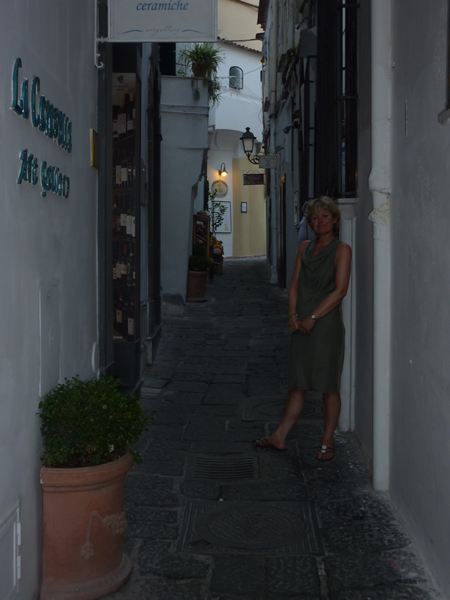 After the isolation of Stromboli, Amalfi is a riot of colour and noise. The entire coast is set against a backdrop of mountains with sheer drops to the sea below and the occasional smudge of terracotta where villages have grown up around natural harbours on this uncompromising coastline. Amalfi is busy: we call ahead on the VHF and a deeply bronzed man in a white vest with a mop of bleached blonde hair and a flashing smile greets us in a red rib and directs us into the port.
After the isolation of Stromboli, Amalfi is a riot of colour and noise. The entire coast is set against a backdrop of mountains with sheer drops to the sea below and the occasional smudge of terracotta where villages have grown up around natural harbours on this uncompromising coastline. Amalfi is busy: we call ahead on the VHF and a deeply bronzed man in a white vest with a mop of bleached blonde hair and a flashing smile greets us in a red rib and directs us into the port.Marco and his brothers own a single pontoon and when we arrive there are already five large motor yachts tethered, with owners and their guests lunching in the shade. We reverse in and perch on the end of the pontoon with lines provided by Marcos helpers. Soon after our arrival, the charter yachts start to arrive and Marco boards these craft from his rib, taking the helm from the bemused occupants, then powers into the port at full speed with just inches to spare and with a blast of reverse he tucks each boat neatly into the small space of water between his pontoon and the rocky shore.
The town is just as you might imagine Amalfi to be: a main square with cobbled stones crowded with happy holiday makers wandering aimlessly, eating gelati as they gaze about them; a majestic flight of wide stone steps beneath a gaudy baroque cathedral and all around a labyrinth of narrow streets leading into small piazzas where souvenir shops and restaurants abound. We wake early after a quiet night on the pontoon and go to buy fruit and vegetables from a store in a dark alleyway we have seen the night before. The owner directs us to a bakery, hidden away in another corner of the piazza and we buy hard, crusty Italian bread and marmalade croissants for breakfast. The mistral is back again and we are warned by Marco's brother that there is a big sea running in the bay of Naples. We are smug that the big motor boats can't leave port and we set off around the headland to Sorrento, where we are meeting Nick and Claire Oulton who are our guests for the next week.
After an extravagant dinner ashore at Il Buco with the Oultons, the following morning we take a taxi to Pompeii. It is simply extraordinary. When Vesuvius erupted with such devastation in 79 AD, Pompeii was covered deep in a bed of ash and it remained frozen in time for fifteen hundred years until it was discovered in 1594 and excavation began in 1748. As a consequence it is beautifully preserved, with entire buildings almost intact, adorned with beautiful frescos and colourful mosaics and we wander through the streets and gardens in the baking heat, ending up in the huge amphitheatre which appears almost too good to be true, with hardly a stone out of place.
We return to the port in Sorrento and set sail for Capri, Italy's most famous island, a mere 10 miles offshore. We anchor in a bay with a hundred other boats and the swell sets us all rolling, our masts like pendulums rocking back and forth in the waves that are being propelled towards us by the mistral in the Golfe de Lion. After a bumpy night, Fatty goes with Nick and Claire to explore the island, while I am ferryman, dropping them off at the busy dinghy dock and collecting them three hours later. They have been up to the Roman palace at the top of the cliffs where the emperor Tiberius is said to have enjoyed throwing unwelcome guests onto the rocks below.
After over-night stops at Procida on the mainland and on the tiny island of Vento Tene, we sail the short distance to Ponza. Ponza is famed for its beauty and we motor around the island, passing sandy bays under high cliffs of chalky white stone where the swell works its way in as the mistral continues to rage around Corsica and Northern Sardinia. We anchor just off the town of Ponza in a wide bay on the sheltered eastern coast, protected from the swell, and we spend the afternoon lazing around and snoozing in the thick afternoon heat. In the evening we take the rib across the bay into the harbour of Ponza and we love it. The fleet of rusty fishing boats moored in the port are preparing for their nights work and they give a utilitarian substance to this otherwise frivolous island. A single path winds lazily up from the port, lined with glamorous boutiques and elegant restaurants under billowing white canopies which spill onto the pavements, creating an air of casual sophistication. After a peaceful night we leave our anchorage in the quiet dawn as a deep red sun rises over the horizon and we shape a course for Ostia and il Porto di Roma.




















Our favourite place in the Med......
ReplyDelete